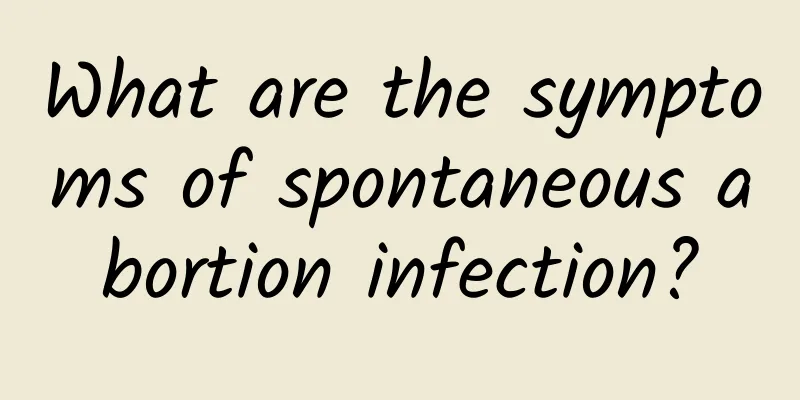What are the symptoms of spontaneous abortion infection?

|
Symptoms of spontaneous abortion infection include fever, lower abdominal pain and abnormal vaginal discharge, and timely medical treatment and disease assessment are required. Post-abortion infection is usually caused by uterine cavity residue, improper operation or low immunity, which may lead to complications such as endometritis and pelvic inflammatory disease. Drug treatment, uterine curettage and enhanced care are needed to relieve symptoms and prevent worsening of the disease. 1. Fever is a common symptom of spontaneous abortion infection. The body temperature may continue to rise to above 38°C, accompanied by chills or general fatigue. This is the body's immune response to bacterial or viral infection, indicating the possibility of endometritis or pelvic inflammatory disease. It is recommended to use antibiotics such as cephalosporins, amoxicillin or metronidazole for anti-infection treatment under the guidance of a doctor, and pay attention to rest and hydration. 2. Lower abdominal pain is a typical manifestation of infection. It may manifest as persistent dull pain or paroxysmal colic. The pain is mostly located in the middle or both sides of the lower abdomen. This pain is usually caused by uterine or pelvic inflammation. In severe cases, it may radiate to the waist or thighs. During treatment, analgesics such as ibuprofen and acetaminophen can be used to relieve symptoms. If necessary, B-ultrasound examination is required to exclude uterine cavity residues. 3. Abnormal vaginal discharge is another important sign of infection. The discharge may be purulent, bloody or accompanied by a peculiar smell, and the amount is large and lasts for a long time. This symptom indicates the possibility of cervicitis or vaginitis, and the discharge needs to be cultured in time to identify the pathogen. Vaginal suppositories such as clotrimazole and metronidazole can be used for treatment. At the same time, pay attention to personal hygiene and avoid sexual intercourse until the symptoms disappear completely. 4. Spontaneous abortion infection may also be accompanied by systemic symptoms such as fatigue, loss of appetite, nausea, etc. In severe cases, sepsis or septic shock may occur. These symptoms indicate that the infection may have spread throughout the body and require immediate hospitalization. Treatment measures include intravenous antibiotics, fluid support therapy, and surgical intervention when necessary, such as curettage or abscess drainage. Spontaneous abortion infection should be taken seriously. Once symptoms such as fever, lower abdominal pain or abnormal vaginal discharge occur, you should seek medical treatment immediately for standardized treatment. Timely use of antibiotics, analgesics and necessary surgical interventions can effectively control the infection and prevent complications. At the same time, patients need to pay attention to rest, strengthen nutrition and maintain good personal hygiene habits to promote physical recovery and reduce the risk of reinfection. Regular review and follow-up are also important links to ensure the effectiveness of treatment, which helps to detect and deal with potential problems in a timely manner. |
<<: What tests are needed for fallopian tube tuberculosis
>>: Can I have intravenous infusion when menopausal syndrome occurs?
Recommend
Is it really a blessing to not gain weight? Don't be silly~3 major health crises are lurking
"Great! You never gain weight!" Most pe...
Experts tell us what are the treatments for female cervical hypertrophy?
Cervical hypertrophy is a type of cervical diseas...
What are the causes of dysmenorrhea?
Dysmenorrhea can be caused by colds, psychologica...
Bacterial vaginosis can be cured without sexual intercourse
Bacterial vaginitis should be treated by removing...
Can reducing the sugar content in bubble tea help eliminate abdominal obesity? Nutritionist: 3 more secrets to control sugar!
"Boss, I want warm bubble milk tea with thre...
4 ways to prevent bacterial vaginosis
Bacterial vaginitis is mainly caused by Gardnerel...
Eat brown sugar boiled eggs to prevent aging! Is brown sugar really more nutritious than white sugar?
Drinking brown sugar ginger water in cold weather...
The reason why you can’t lose weight in summer is actually related to two major culprits! Doctor Liu Boen: 2 breathing exercises to get rid of cold factor obesity
The weather is hot in summer, and people have poo...
Can people with vaginal candidiasis exercise?
Can you exercise normally if you have vaginal can...
Don't touch it! Fried and pickled foods can cause premature aging
The famous Taiwanese chef Chef A-Chi once said, &...
[Video version] Do you have to sweat profusely to lose weight? Famous doctor relies on low-impact "Niya exercise" to lose weight
"Why can't I lose weight even though I e...
What are the causes of uterine fibroids? These 5 types of people are most likely to suffer from uterine fibroids
Uterine fibroids are the most common benign tumor...
Methods of TCM Syndrome Differentiation for Treating Amenorrhea
Amenorrhea brings a lot of pain to patients and s...
How much progesterone is considered an ectopic pregnancy?
Progesterone levels play an important role in dia...
Stress-induced insomnia may alert you to functional uterine bleeding
Survey results show that among office workers, th...









